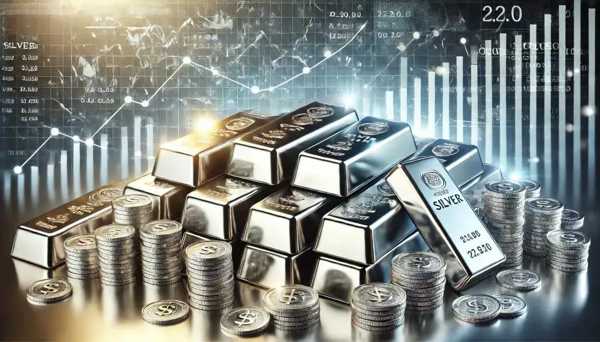In recent years, silver has quietly positioned itself at the crossroads of technology, sustainability, and investment opportunity. While gold continues to capture headlines as the ultimate safe haven, silver’s dual identity — both as a precious metal and as a critical industrial resource — is generating renewed interest among investors. From electric vehicles to solar panels, the world’s accelerating transition toward cleaner energy is placing unprecedented pressure on silver supplies. The question on many minds is simple: are we witnessing the early stages of a long-term silver supercycle?

Silver’s Expanding Role in the Green Economy
Silver’s physical properties are unique among metals. Its unmatched electrical conductivity, high thermal efficiency, and strong reflectivity make it indispensable across many modern industries. The rise of renewable energy technologies has been particularly significant. Each new solar panel requires silver paste to conduct electricity effectively, and with solar installations growing at record rates, industrial demand continues to soar.
The same is true for electric vehicles (EVs). Compared with traditional cars, EVs use up to twice as much silver in their wiring, sensors, and electronic control systems. As automakers expand their EV lines to meet emission targets, silver’s role in the transportation sector is becoming even more critical. Beyond energy and mobility, silver is also used in 5G devices, medical coatings, water purification systems, and advanced semiconductors — all industries poised for rapid growth through 2030.
Yet industrial demand is only half the story. In uncertain economic times, silver’s traditional role as a store of value attracts a different kind of investor. Inflation, geopolitical tension, and currency devaluation have all contributed to renewed interest in physical silver and related investment instruments. This unique overlap between industrial utility and financial security positions silver as one of the most versatile assets of the decade.
Investment Pathways: From Physical Metal to Digital Exposure
There are several practical ways to gain exposure to silver, depending on an investor’s goals, liquidity needs, and risk tolerance. The most straightforward option remains physical silver — coins, bars, or rounds purchased from reputable dealers. Direct ownership offers tangible security and a hedge against inflation, though it comes with costs for storage and insurance.
Exchange-traded funds (ETFs) provide a simpler way to mirror silver’s market price without handling the metal itself. These funds, which hold physical silver in vaults, are traded like stocks and offer high liquidity. For those seeking leveraged potential, silver mining stocks can amplify price movements. When silver prices rise, mining company profits often increase at a faster pace. However, these shares also carry operational risks tied to management efficiency, labor conditions, and geographic factors.
Experienced investors may turn to futures and options, allowing them to speculate on silver’s future price with leverage. While this approach can yield large gains, it also exposes traders to significant losses during volatility. Others prefer pooled storage accounts, where ownership of vaulted silver is shared among multiple clients under custodial management — a convenient middle ground between physical and paper silver.
Understanding Silver’s Market Dynamics
Silver is notoriously volatile. Because it serves both as an industrial commodity and an investment asset, its price can react sharply to a wide variety of global events. When manufacturing activity slows, industrial demand contracts, weighing on prices. Conversely, during periods of inflation or financial uncertainty, investment demand surges, driving rapid appreciation. This push-and-pull dynamic means silver often moves faster than gold — both upward and downward.
Historically, silver tends to outperform gold during bullish phases in the metals market. The gold-to-silver ratio, a key valuation indicator, provides context: when the ratio rises above 80:1, silver is often seen as undervalued relative to gold. When it narrows toward 40:1, the reverse may be true. Monitoring this ratio can help investors identify favorable entry points.
Despite its volatility, silver has demonstrated resilience as a long-term store of purchasing power. Its cyclical nature makes it most effective as part of a diversified portfolio rather than a primary holding. Financial planners typically recommend limiting total precious metal exposure — gold, silver, and related instruments — to around 5–10% of total assets.
Managing the Risks
Like any investment, silver carries risks that must be managed strategically. Price swings can be sudden and severe, leading to emotional decision-making if not planned for in advance. Storage costs and premiums can erode profits on physical silver, while ETF management fees reduce net returns over time. Mining equities may underperform even in rising metal markets if production costs or political instability impact operations.
Global economic cycles also matter. Because much of silver’s demand comes from manufacturing, recessions can temporarily depress consumption. Currency fluctuations, particularly the strength of the U.S. dollar, further influence pricing since silver is traded internationally in dollars. Savvy investors diversify across different forms of silver exposure — for example, combining physical holdings with ETFs or mining shares — to spread risk.
Looking Ahead: A Metal Shaped by Innovation
What sets silver apart in 2025 and beyond is its deep integration into technologies shaping the next decade. Demand for solar power is projected to double by 2030, while EV production could exceed 80 million units annually. Both sectors rely heavily on silver. Meanwhile, ongoing research into nanotechnology, medical applications, and energy storage is revealing new industrial uses. Supply, however, remains constrained. Many silver mines also produce lead, zinc, or copper, meaning their output depends on the profitability of other metals. This structural limitation could tighten supply further if demand keeps rising.
Final Perspective
Silver’s story is one of transformation — from a traditional store of value to a strategic industrial asset essential to the world’s clean-energy future. While short-term volatility can test investors’ patience, the underlying trends supporting silver are difficult to ignore. Those who approach it with discipline, diversification, and a long-term view may find themselves well-positioned to benefit from the next chapter of the silver market’s evolution. Whether or not a “silver boom” becomes reality, silver’s importance in the global economy is set to shine brighter than ever.
